Sharlyn J. Lauby's Blog, page 89
November 19, 2019
The 7 New Rules of Work: Workforce Readiness In the Digital Age

(Editor’s Note: Today’s article is brought to you
by
our friends at SilkRoad
,
a provider of strategic onboarding solutions to drive workforce readiness and
organizational transformation. Check out their research, “
The Value of
Employee Engagement in the Age of Digital Disruption
” a valuable
report for any HR leader who wants to see engagement and onboarding from the
C-suite. It’s a must-read for any human resources professional. Enjoy the
article!)
Disruption has become a common business term. It was
introduced by Harvard Business School professor Clay Christensen in his book, “The
Innovator’s Dilemma”. Disruption, as defined by Christensen, means to
provide a product or service to a market that previously couldn’t be served OR
to offer a simpler, cheaper more convenient option to an existing product.
You’ll notice that disruption doesn’t mean better. Over time, people have
started tossing around the word disruption for every new thing on the market.
Whether the company’s product or service is truly disruptive,
I’ll leave that for you to decide. But one outcome I’ve noticed about
disruption is that it requires us to think differently about work. That shift
in mindset was a key theme at this year’s SilkRoad Connections 2019 conference.
Opening keynote speaker Polly
LaBarre, author of the New York Times best-seller “Mavericks at Work: Why the
Most Original Minds in Business Win”, challenged us to think about our
workplaces in a different light.
One of the big takeaways for me was, instead of organizations creating rules for each different workplace situation, the goal should be to create rules that apply all the time. Let those rules drive company culture. LaBarre shared seven rules of work that she believes define how employees want to work today.
But before you scroll down and check out LaBarre’s new work
rules, let me add that with each of these rules comes some training. I don’t
know that employees are graduating from school with these skills. I don’t know
that employers are making skill development in these areas a priority. Getting
the future workforce ready for the new rules of work includes training.
1. Everyone has power. Fans of HR Bartender know that we have talked about workplace power for years. There are many different types of power, but they all do the same thing: influence. Organizations and individuals need to realize that power exists at every level of the organization and teach people how to identify and use their power responsibly.
Two programs where organizations can introduce the concept of power
include leadership and management skills training. Power can also be discussed
in manager orientation and onboarding. And if you really want to disrupt
workplace thinking, consider having a “Leadership 101” session for all new
hires where the company can talk about leadership, power, and influence – again,
at all organizational levels.
2. Nobody is smarter than everyone. The amount of work being done through collaboration has dramatically increased over the past decade. This means that organizations need to focus on developing employee collaboration skills.
Developing collaboration skills can take place during team
development sessions. Not team building, that’s something different. Team
development focuses on those skills that we need to be a good team member, such
as problem-solving, decision-making, etc. Training in these areas should be
made available to all employees as part of their onboarding process.
3. All ideas are heard. Listening skills are vital in everyday business conversations. Employees need to listen to customers, co-workers, and their managers. In turn, managers need active listening to have effective one-on-one meetings with employees. Finally, senior management must listen for feedback from employees and customers. It’s a continuous cycle.
When we talk about listening, we’re not just referring to the spoken
word. Listening includes all communications like video, email, phone calls,
etc. What’s great about listening skills is that we can build short activities
into everything we do versus one big training session.
4. Challenging ideas is acceptable and encouraged. This conversation needs to start during the interview process. Organizations might want to ask candidates, “Tell me about a time when you challenged a company decision.”
Being an organization that says challenging ideas is okay and one that
does it are two different things. The way to show that this isn’t just an empty
statement is with actions. It also takes some conflict management training,
which is probably better at the front end of an employee’s career.

5. Passion is the most powerful currency. Right now, there’s a debate about the role of passion in career development. I believe it really comes down to how you define passion. It could be viewed as connection, which is very powerful.
I could also see how someone might
say, “You can’t teach passion. It just needs to be there.” The part you can
train is in the area of confidence. We like (or are passionate about) things we
do well. In addition to the soft skills we’ve talked about so far, it’s
important that employees feel confident they can do the technical aspects of
their job.
6. People design their own jobs. This plays off of #5 above. When employees are confident in their abilities, they will want to drive how work gets done. We’re not talking about employees deciding that they don’t want to do a job task. This is about empowering employees to do the work their own way.
One way to think of empowerment is in the context of self-management.
This ties in skills like problem-solving, decision-making, and technical skills
into self-managed career development.
7. Values rule decision-making and accountability. The final rule ties all of the other rules of work together. Company values should already be the guiding principles of the organization.
Managers and human resources will
want to ask questions about values during interviews. Orientation and
onboarding programs need to be aligned with values. Performance management and
career development programs should be aligned with values as well. Once
expectations are set, now it’s time to hold people accountable for living the
organization’s values.
These new rules of work could be shared with candidates
during the interview process by hiring managers, highlighted in preboarding
communications from senior management, touched upon during orientation by HR,
and discussed at great length during onboarding around the entire organization.
It’s how the new rules of work become engrained in culture.
If companies want to compete for talent in today’s business
world, they have to change with the times. That doesn’t mean just offering new
products and services or updating equipment. It means changing the rules of
work so employees can deliver on the new ideas they are being asked to
implement.
P.S. If you want to stay on top of trends about the future
of work, check
out SilkRoad’s Workforce 2030 podcast series hosted by Alexandra Levit.
Organizations that want to disrupt the market have to disrupt their workplaces.
The good news is you don’t have to get your ideas all alone. I’m honored that
Alex asked me to join her for a conversation about the skills gap. Hope you’ll
check it out.
The post The 7 New Rules of Work: Workforce Readiness In the Digital Age appeared first on hr bartender.






November 17, 2019
Generalist or Specialist: Which is Better
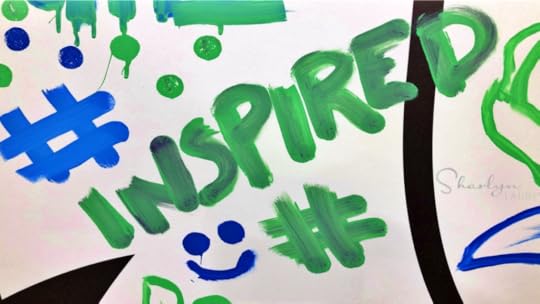
During this year’s HR Technology
Conference and Expo, I saw a comment that intrigued me.
“The old career model is over. Generalists are going to rule the world. They see and do everything and have a broad perspective. They see patterns. Create opportunities in your company for employees to move around to develop different skills.”
I must admit that I have some strong opinions
about this one. Organizations need both generalists and specialists. No
organization can exist with an entire workforce of generalists. Or an entire
workforce of specialists. History has shown us that. The business world is
constantly vacillating between “Generalists are going to rule the world.” and
“Specialization increases your company’s value.” The fact that we keep going
back and forth about the value of each should tell us that we need them both. And
organizations should want to have both.
But I do agree with the last part of the
comment about organizations needing to create opportunities. This is the part
we regularly miss. Generalists often become good at what they do because they
change companies instead of being able to expand their experience internally.
And I don’t want to leave specialists out of
the conversation. Specialists often get better at their area of expertise by
being exposed to different situations. Specializations do not get developed in
silos. In fact, specializations can get stronger by being a part of
cross-functional teams and exposure to complementary disciplines. Talent
acquisition and onboarding are great examples. Talent acquisition professionals
should have an understanding of onboarding, even if they’re not responsible for
it, because it will make them a better TA pro.
Whether you’re a generalist or specialist, here
are a few things to consider:
Look for opportunities to strengthen your core
responsibilities. Regardless of being a specialist or
generalist, we all have a handful of things that we spend the majority of our
time on. Consider those your “core” responsibilities and work at being really
good at them. That’s going to open doors for you.
Accept stretch assignments to learn new things.
When offered an opportunity to do
something a little outside of your core responsibilities,
don’t immediately say “no”. Think about whether the stretch assignment could
help you with an aspect of your core responsibilities. Could it introduce you
to people who will help your career? Does it allow you to showcase your
specialization to a new audience?
Leverage the other person’s perspective.
If you’re a generalist, look for specialists to bounce ideas off and get a new
viewpoint. Same goes for specialists. Find a generalist to brainstorm with.
This is the beauty of building relationships with people outside of your inner
circle. We learn new things.
Organizations need both generalists and specialists to remain competitive and achieve their goals. Individuals need generalists and specialists to be the yin to their yang. Instead of trying to make one sound more important than the other, let’s focus on how to create opportunities that make them both – and, ultimately, the organization – successful.
Image captured by Sharlyn Lauby at the Qualtrix X4 Summit in Salt Lake City, UT
The post Generalist or Specialist: Which is Better appeared first on hr bartender.






November 14, 2019
Bookmark This! Employee Onboarding Edition
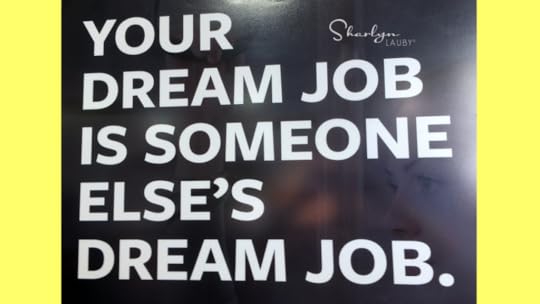
I cannot emphasize enough the importance of good employee onboarding. This is the organization’s opportunity to do two things. First, it’s the new hire’s first impression of the company. I’m not discounting the candidate experience, but this is the first impression as an actual employee.
Which leads to the second big thing that onboarding does. It
tells the new hire whether all of the things the company said during the hiring
process are true. Is the company authentic and truthful?
If you’re thinking about evaluating your onboarding process, here are a few articles worth checking out:
Pre-Boarding:
Bring High Tech and High Touch to Onboarding
Pre-boarding has been introduced as the paperwork subset of onboarding employees. Xerox offers a solution to pre-boarding paperwork management.
Onboarding:
Take Your Process from Basic to Strategic
Onboarding is the foundation of employee engagement. Be strategic in your onboarding process following these 4 trends that engage new hires.
Onboarding
Is Your Foundation for the Employee Experience
Madeline Laurano, founder at Aptitude Research, discusses the two touchpoints in the employee experience that onboarding should address.
New
Hires Not Engaged? How to Design an Onboarding Intervention
Onboarding is where engagement starts. That’s why an onboarding pulse or check-in is important. If new hires are not engaged, learn how to design an intervention.
Onboarding
Is Successful When Expectations Are Met
Onboarding new hires is all about setting expectations. If you don’t, you can expect disengagement and disappointment from employees and managers.
New
Hire Onboarding: Take a Pulse to Increase Employee Retention
Employee retention is critical today. A pulse survey can help when used during onboarding. Readex shows how to structure and deliver an effective onboarding pulse survey.
How
to Evaluate the Success of Your Company’s Onboarding Program
Good onboarding is the key to new hire success. To evaluate the impact of your onboarding program, SilkRoad shows us 5 effective data and feedback methods.
In a Korn Ferry Futurestep survey, 98% of executives said the key to employee retention was having a well thought out onboarding program. Organizations with terrific onboarding programs should be regularly evaluating their outcomes and making adjustments. Because just as the recruitment market is changing, the way we set new employees up for success is changing as well.
Image captured by Sharlyn Lauby after speaking at the MBTI Users Conference in San Francisco, CA
The post Bookmark This! Employee Onboarding Edition appeared first on hr bartender.






November 12, 2019
4 Key Elements of a Successful Labor Law Posting Strategy #MindTheGap

(Editor’s
Note: Today’s article is brought to you by our friends at
Poster Guard®
Compliance Protection, a
division of HRdirect and the leading labor law poster service that gets your
business up to date with all required federal, state and local labor law
postings, and then keeps it that way — for an entire year. Enjoy the article!)
In the first two articles
in this #MindTheGap series, we’ve talked about the labor law posting
requirements for unique employee groups and different industries.
While most employers know they need to have labor law postings, I can see organizations forgetting to “mind the gap” where postings are concerned and forgetting to take the extra caution that needs to take place with three unique employee groups: 1) applicants, 2) Spanish language postings, and 3) remote workers.
I’d like to add another thing we need to “Mind
the Gap” about: every organization isn’t the same when we’re talking about
labor law postings. There are industry specific labor law posting
requirements
that apply to different industries like hospitality and health care as well as
companies with federal contracts.
As
human resources professionals, compliance is a key part of our roles. That
doesn’t mean it needs to consume the majority of our time. We need to have a
strategy to maintain compliance. That allows us to be proactive versus
reactive. So, to
wrap up this “Mind the Gap” series, let’s discuss the four key elements in a labor
law posting strategy.
1. Understand the purpose. The purpose of labor law postings is to inform employees of their legal rights and responsibilities under federal, state, and local regulations. Organizations that are only focused on federal and state postings aren’t doing enough. For example, did you know that Denver, Miami Beach, New York and Tucson all require anti-discrimination postings? They do.
Labor law postings aren’t some dreamt
up form of punishment. They provide education to employees. That shows
employees the organization cares about their well-being, which attributes to employee
engagement and retention. Don’t minimize how little acts that demonstrate
caring through employee education can provide value. Organizations should treat
labor law posters as such.
2. Communicate to everyone. I’d like to think it’s pretty obvious that if you have multiple locations then you need multiple sets of posters. But also think about if you have a single, large location. Is there someplace that you can guarantee every employee will walk by and see? And what about remote workers? Think about #1. The purpose of labor law postings is to educate employees. Which means they need to see them.
When it comes to employee
communication, displaying only one set of posters may not be probably won’t be enough. Organizations will want to be strategic about
isn’t
posting locations. Look for places where employees hang out so the company is
ensured they can be viewed by employees throughout the workday.
3. Update continuously. Labor law posting changes happen all the time. Not just in January. According to Ashley Kaplan, Esquire, senior employment attorney for HRdirect, there are on average 150 state posting changes annually and at least half of them require an immediate poster update or replacement. If you’re only updating postings once a year, then it’s possible probable that you’re not in compliance.
This ties into #1 and #2.
Not only do organizations want to make sure that everyone knows their legal
rights, but they need to know them in a timely fashion. Telling
an employee that their rights changed six months ago doesn’t send the message
to employees that the organization cares about them or being compliant. And
I’ll say what we know our employees are thinking…if the company isn’t doing
compliance activities like labor law postings, what other compliance aren’t
they doing?
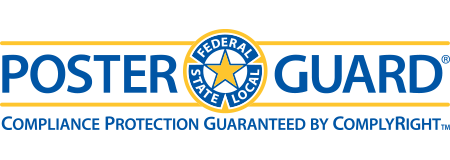
4. Use your time strategically. There are 175 different government agencies nationwide that are responsible for 395 mandatory posters. Sure, you can monitor all of the relevant agencies for changes and request free posters. That takes time. A lot of time. I don’t know about you, but that’s not how I want to spend my time. If I have to choose between spending an hour monitoring for free labor law posters and coaching a manager on how to get better performance from an employee, I know which one I’ll be doing.
Now of course, I get it.
Those downloads from agencies are free. I don’t have anything against free. I
like free. But there are some things that even when you can get them for free,
it’s not worth paying for. You know what I’m saying. Be smart about how you
spend your valuable time.
The good news is having a
labor law posting compliance strategy doesn’t have to be complex. Organizations
can partner with outside services that will handle the heavy lifting for you. Our friends at Poster Guard have a
Labor Law Poster Service that does just that. Yep, that’s right. Poster Guard monitors
labor law requirements (at the federal, state, and local level) and lets you
know when things change. They also provide you with replacement posters every time there’s
a change FREE of charge!
As you’re putting together your budget for
next year, think about how you want to spend your time. How do you
create the most value for your organization?
The post 4 Key Elements of a Successful Labor Law Posting Strategy #MindTheGap appeared first on hr bartender.






November 10, 2019
Recruiters: Hiring Veterans Made Easy
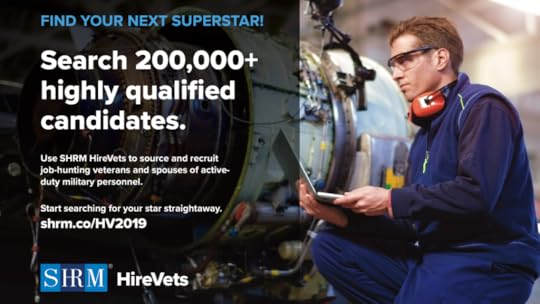
(Editor’s Note: Today’s post is brought to you by our
friends at the
Society for Human
Resource Management (SHRM)
. With over 300,000 HR and business
executive members, SHRM creates better workplaces where employers and employees
thrive together. Don’t miss the
SHRM
Annual Conference & Expo on June 28 – July 1, 2020 in San Diego
.
Enjoy the article!)
Readers of this blog know that
I’m a facilitator for SHRM’s seminars. One of the seminars that I facilitate is
Talent
Acquisition: Creating Your Organizational Strategy. During the program, we talk about hiring veterans.
In a great video that we show
during the seminar, Justin Constantine, retired lieutenant colonel in the U.S.
Marine Corps, and Florent Groberg, retired U.S. Army Captain and Medal of Honor
recipient, have a discussion about one of the biggest challenges with hiring veterans
– deciphering the military occupational specialty (MOS). Every time I see this
video, I’m reminded of a breakout session I attended years ago at SHRM’s Talent
Conference where the speaker spent an entire hour breaking down how to read the
MOS. Think about it as trying to learn a new language in an hour. It’s tough!
The reason I’m bringing this up
is because I know organizations want to hire veterans. Organizations want to
hire the best talent and veterans can bring their value to our organizations. But
let’s face it. When a recruiter has 20, 30, or more requisitions on their desk,
it’s hard to find time to learn all those MOSs. Wouldn’t it be great if there
was some way to find terrific candidates and get a shortcut in translating
military codes?

SHRM HireVets Brings Connections
and Education
Recently, I had the opportunity to do a test drive of the SHRM HireVets platform. This product was created in partnership with JobPath, a veteran and military spouse careers platform that attracts over 24,000 new users every month and has more than 200,000 users currently accessing its wide variety of resources. Job-seeking veterans and spouses of active-duty military personnel can leverage JobPath’s powerful technology to easily create customized resumes, take over 200 online courses, and connect with mentors for career guidance.
The site provides that shortcut we’re
looking for in two big areas when it comes to veteran recruiting: 1) Connection
and 2) Education.
1. CONNECTIONS VIA CANDIDATE MATCHING AND SEARCH
SHRM HireVets has a candidate
matching function that will take your existing job postings and conduct an
internal match from within the SHRM HireVets database. Please note: SHRM
HireVets isn’t a job board and your job posting isn’t going public. If you’re
wondering about the composition of the SHRM HireVets database (because I would
be), SHRM shared with me that the expertise areas of their data base include:
Transportation – 19%, Information Technology – 18%, Manufacturing/Operations –
17%, Defense Industry – 15%, Construction/Skilled Trade – 15%,
Accounting/Finance – 13%, Security/Law Enforcement – 12%, and Health Care – 10%.
In addition, the geographic
regions represented include Texas – 10%, California – 7%, New Jersey – 7%, New
York – 7%, Florida – 6%, North Carolina – 5%, Georgia – 4%, Pennsylvania – 4%,
Illinois – 3%, and Tennessee – 3%.
In addition to the candidate match
feature, you can do a single job search as well as provide your applicant
tracking system (ATS) feed, so it happens automatically. So SHRM HireVets
functions very similarly to other career sites and responds
to traditional Boolean search commands. All
you need to conduct a basic search is a job description keyword or job title
and a zip code. You’ll receive a list of matches that allow you to view resumes
online so you can reach out to candidates directly.
2. EDUCATION ABOUT THE MILITARY OCCUPATIONAL SPECIALTY
Let’s say you’re at a job fair and a veteran introduces themselves as an “88Mike”. I don’t know about you, but my first response would be “What’s that?” The SHRM HireVets platform allows us to look up the code 88Mike and learn that the person was a motor transport operator. Not that you’re going to stop the conversation and look it up…but with the SHRM HireVets military job translator, we have the ability to do our research and know those codes that will immediately register with us. If my company is looking for drivers, I want to talk with “88Mikes”.
The reverse is also true.
Organizations can enter the category of jobs they’re looking for in the SHRM
HireVets platform and learn the MOS they should be on the lookout for. For
example, your company needs nurses. You can look on SHRM HireVets using the
keywords RN or Paramedic. Then, you can filter by military branch. Because not
only is military occupational specialties different from what we post in the
public and private sector but they’re different between the branches of the
service.
You don’t have to use the MOS translator to
take advantage of the candidate matching and single job search features. But I
can see it being very helpful in sourcing qualified candidates.

Hire the Right Veterans for Your Jobs
Organizations
are always looking for qualified candidates. Even more so in today’s
competitive talent landscape. Veterans have proven experience doing a great
job. We just need to create the win-win. Because we all know hiring the wrong
person is expensive and doesn’t contribute to organizational productivity.
The
SHRM HireVets platform offers you a tool that will not only hire a veteran but
to hire the right veteran. The candidate who has
the knowledge,
skills, and abilities that align with your job
requirements. If you want to learn more about how the SHRM HireVets platform to
bring more qualified veterans into your organization, check it out on the SHRM Store
site. There’s an online
FAQ and short
demo you can preview as well.
The post Recruiters: Hiring Veterans Made Easy appeared first on hr bartender.






November 8, 2019
Employee Experience: Surprise Employees In a Good Way
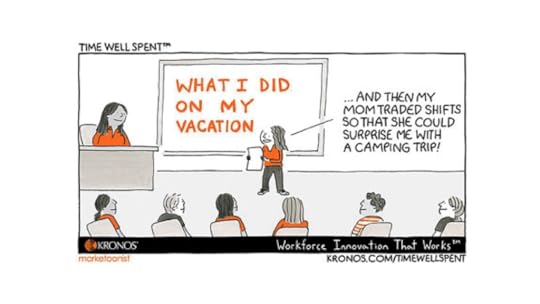
Personally, I’m not a big fan of surprises. But I do understand how others might enjoy them and want to have a few surprises in their life. And in the workplace, it may be a welcome part of the employee experience. That’s why I love today’s Time Well Spent from our good friends at Kronos. You can just tell that this surprise was welcome and appreciated.
And that’s the point of surprises. They’re
supposed to be good. I’m not sure that anyone wants a negative or bad surprise.
At least I can’t think of one. And we can’t just assume that everyone will like
a surprise just because we might think it’s great. Organizations need to think
about how an employee will receive the surprise.
Performance shouldn’t be a surprise.
The first surprise I’m reminded of is performance reviews. I cannot begin to
tell you how many times an employee has complained to me that their performance
review was a complete surprise to them. And not in a good way. Managers should
be having performance conversations with employees all the time. Employees
shouldn’t have to wait months or years to hear how they’re doing. When it comes
to a good employee experience, you’ve heard me say this before but I’ll say it
again, “’No news is good news’ isn’t a performance management program.”
Remember surprises are like recognition.
Managers want to surprise employees similar to the way they recognize them. In
a way that is meaningful to the employee. I still remember when I became a vice
president. I got called up in front of the entire company during a meeting. I
had no idea it was coming. I was totally mortified. The surprise was great for
my boss. Me? Not so much. And I’m confident she would have never understood if
I told her how I felt.
Informal lines of communication can soften a
surprise. Translation: the
company’s gossip or rumor mill can serve a valuable communication purpose every
once in a while. But that’s predicated on a couple of
things. First that HR and senior management understand how the informal lines
of communication work and second, that they know how to use them. An example
would be if the company is planning some sort of layoff, can those informal
communications help (or hurt) future messaging.
Organizations could improve their
relationships with employees and create a positive employee experience if they
looked for ways to send good surprises. It could be positive
feedback for a job well done. A pizza party
for a team that met a milestone. Or telling a manager to take the afternoon off
and you’ll cover the rest of their shift. Those are the kind of surprises that
delight employees and build positive morale.
The post Employee Experience: Surprise Employees In a Good Way appeared first on hr bartender.






November 7, 2019
Labor Unions May Become the Voice Of the Workforce

A few weeks ago, I mentioned that I took a
MOOC (massive open online course) from MIT on “Shaping
Work of the Future”. One of the topics that I felt the
course spent a lot of time on was the idea of a new employee – employer social
contract. This totally makes sense to me.
As they were talking about the key
stakeholders in the new social contract, they mentioned labor unions. It got me
thinking. The latest numbers from the Bureau
of Labor Statistics show union participation at about
10.5 percent or roughly 14.7 million people. That’s a significant decrease from
1983 when the first union membership data was available, and the rate was 20.1%
and 17.7 million workers.
I’m sure you’ve been paying attention to the recent
autoworker strikes. Or the teacher strikes. On some
level these are classic labor – management disagreements about pay, benefits,
and working conditions. Organizations have been showing healthy profit lines
for a few years now (since the Great Recession). And we know from the monthly
jobs reports that employee wages are not increasing at a comparable rate.
But as I’ve been reading about these labor and
management challenges, it reminded me of this conversation about the new
employee – employer contract and unions. Is it possible that labor unions can
and will find a way to reinvent themselves? Will labor unions become more than
an organization that fights for employee pay and benefits?
As more people talk about automation and artificial
intelligence eliminating jobs, I can definitely see unions becoming a solution
for employees who are concerned that their jobs will be eliminated. Especially
if the company doesn’t share any type of plans to reskill or upskill their current
workforce.
I also think there could be a new reason that
employees join unions. And that’s to have a voice. Workers expect management to
listen to them. Think about some of the current workplace conditions we’re
hearing employees are being exposed to:
Sexual
harassment and retaliationWorkplace
threats and violenceDiscrimination
and a lack of equitySafety
and environmental concerns
Could this alter the perception of unions? Will employees who used to join a union to get work security now join a union because they can get a voice? I don’t know that I have all the answers. But this recent survey from the Good Companies, Good Jobs Initiative at MIT Sloan indicates that half of non-unionized workers want to join a union (up from a third in previous surveys).
Organizations need to think about unions. And that doesn’t mean in a bad way. I’m one of those human resources professionals who always heard unions were bad. Then I went to work at a hotel where my employment attorney told me the union was the best thing that ever happened because the company had a good relationship with the union. We partnered with the union. Some companies have the same kinds of relationships with unions. This isn’t to say that they agree on everything, but they work together to achieve results that are a win for employees and the company.
All I’m saying is don’t let those participation numbers lull you into a false sense of security. It’s possible that if employees do not feel their needs are being met, they may look for someone to step up and be that voice. And a labor union could become that voice.
Image captured by Sharlyn Lauby while exploring the streets of Havana, Cuba
The post Labor Unions May Become the Voice Of the Workforce appeared first on hr bartender.






November 5, 2019
The Future of Work: Employees Want to Work Their Own Way

(Editor’s Note: Today’s article is brought to
you by
our
friends at Kronos
, a leading provider of workforce
management and human capital management cloud solutions. Managing your
workforce just got a lot smarter with
Workforce
Dimensions, a solution designed to provide both a world-class employee
experience and unprecedented levels of operational insight
.
Enjoy the article!)
In
this series about the future of work, we’ve talked about how employees
want to work smarter through the use of chatbots that
can personalize responses (like “What’s my schedule next week?”) and work
in the modern cloud to learn about an opportunity to pick up an open
shift. There’s one more piece to this future of work series and it has to do
with everyday interactions. Because when it comes to communication, employees
want to “work their own way”.
So,
what does it mean for employees to “work their own way”? It starts with giving
employees excellent tools – like technology – that’s able to help them get the
work done. Honestly, on some level, that’s the easy part. Then, it means for
management to trust
employees and get out of the way
so they can get the job done. I believe that’s the hard part.
The Future of Work
Organizations that allow
employees to “work their own way” aren’t promoting workplace anarchy. They’re still
responsible for setting expectations, providing training, coaching performance,
and giving employees timely information. The purpose of allowing employees to
“work their own way” is to help employees make their work lives easier and more
productive using modern technology tools. Because if organizations can make the
day-to-day stuff employees have to do less cumbersome, then employees can focus
on the real work. You know, the big goals that are going to keep the
organization competitive. Which is work employees want to spend their time on
and what the business ultimately wants. Here are a couple of practical
examples:
Example #1: Allow employees to
access work-related information where they already spend a lot of time.
During a future of work presentation at KronosWorks, I heard that by the year 2020, 25% of internet users will be mobile only. Mobile is no longer a nice to have. It’s a need to have business strategy. And what do people do on their mobile devices? Check Facebook.
Workplace by Facebook allows organizations to send messages like
company announcements, recognition, learning/training, etc. through an
employee’s newsfeed. It also gives employees the ability to collaborate in
terms of sharing content, conducting polls and surveys, and participate in work
chats.
Workforce
Dimensions from Kronos can be accessed from within Workplace by Facebook. This
partnership allows employees to work their own way by picking up extra shifts,
requesting time off through a chatbot, or making a shift trade all within the
business version of the social network that they use regularly. No more using
multiple apps to coordinate schedules and collaborate on projects. Kronos has a
similar partnership with Microsoft Teams, another popular enterprise
collaboration platform.
Example
#2: Allowing employees immediate access to earned wages
Did
you know that 78%
of Americans live paycheck to paycheck?
According to a survey from BankRate, 29%
of Americans have more credit card debt than they do emergency savings.
You can see where I’m going with this one.
I’ve read all the same reports you have that money isn’t a primary motivator,
and that might very well be true. But money still matters. And somedays, money
matters a lot – when a family member has to go to the emergency room or when
the ‘good’ car needs repair. Even what may seem like a good situation on the
surface, like the opportunity to pick up an extra shift at a time-and-a-half
pay rate, can be stressful if there isn’t enough cash tucked away to pay for a
sitter for a few hours. Workforce Dimensions has partnered with several
organizations like Even, Branch, FinFit, PayActiv, SalaryFinance, WageStream,
and Hastee that provide financial wellness and earned wage access, meaning that
employees can work their own way can get paid on the same day.
For example, Walmart gives their employees access
to an earned wage app as a benefit. Over 76% of employees use it weekly to help manage and
budget their money. They can get paid on demand as well as set up an auto
savings deduction. And according to Walmart, participation has helped to drive
employee participation in the company 401(k) and Health Savings Accounts (HSAs).
And while the
concepts of financial literacy and wellness aren’t entirely new, what I like
about Workforce Dimensions is how they’ve taken it to the next level by integrating
financial wellness with timekeeping. It seems logical to me that connecting
earned wage access directly to timekeeping could simplify program
administration for companies. If organizations can create a way to reduce an
employee’s financial stress off the clock, in theory, will allow them to
be fully present at work while they are on the clock.
Employees
Want to Own Their Careers … And Work Their Own Way
What I love
about these two examples is that they put the employee in control of their work
life. Just the simple notion of being able to request time off in real time
without waiting weeks for an approval, or to swap out of a shift at the last
minute without having to jump through hoops to find a replacement and inform
the manager, goes a long way to employees.
While
everyone wants to be able to disconnect from work, the notion of “work is work,
home is home, and the two shall never meet” is an antiquated concept. Employees
don’t want separate phones, apps, and multiple systems to do the simple stuff.
They want to have control over their personal and professional lives. That
includes having greater control over their finances, regardless of how much
money they make.
Bottom-line:
Organizations can’t tell employees that they need to “own their careers”
without giving them the proper tools. Owning your career is about more than
simply training. It’s about being able to get work done the way that works best
for you.
P.S. If you want to learn more about the Workforce Dimensions solution and how it can help your organizations and employees work smarter (and I know you do), visit the Kronos website and request a demo. Organizations that start using artificial intelligence and analytics to manage their workforce will have the clear advantage in the war for talent. That’s the real future of work. The organization wins through reduced administration, more effective scheduling and staffing, and better employee knowledge and skills.
The post The Future of Work: Employees Want to Work Their Own Way appeared first on hr bartender.






November 3, 2019
6 Different Types of Flexible Work for Employee Caregivers
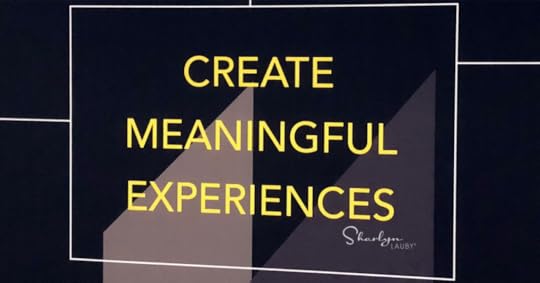
I’ve been working on a few articles over on Unretirement Project about caregiving. One of them focuses on how employee caregivers can talk with their managers about their caregiving responsibilities. But it occurred to me as I was writing that article, it can be tough for managers to remember all of the different types of flexible work and scheduling that organizations have to consider. So, I thought it might be good to start a list.
Of course, the options available are going to
vary based on the job. And even when there are multiple options to choose from,
there will be pros and cons. But the point here is to make sure organizations
are considering all of their options.
Telecommuting means working from home. Organizations and employees need to think about what a work from home arrangement would involve in terms of technology, data security, in-person meetings, etc. Remote work means working outside of the office, which may or may not be at home.Compressed work weeks are when employees work four 10-hour days instead of five 8-hour days. The idea is that employees work the same amount of time in fewer days. I’ve worked for companies where employees who worked second or third shift received the benefit of a compressed work week.Flexible hours can be defined as employees who come in early and leave early OR come in late and stay late. Many organizations accommodate employee family requests in this way. There’s also a subset of flexible hours that might include a mealtime flex or vacationflex (i.e. unlimited vacation time). Job sharing takes place when two people work part-time instead of one person working full-time. I heard a story recently where two full-time school principals were planning their semi-retirement and decided to job share instead of fully retire. Part-time employment most of us are familiar with. It means a less than full-time workload and schedule. On-call or seasonal work isn’t guaranteed at the same levels as full-time or part-time, but it does offer employees the ability to have control over their schedules. Freelancing is the one option where we’re not talking about employees. Freelancers are essentially outside contractors who are paid via Form 1099. But it is an option. Especially if that new contractor knows they’re getting a nice gig with their former employer at the start.
If your organization is considering any of
these options, it’s a good idea to think about what implementation might
involve. Talk with your legal and risk management departments for their
insights. According to Pew Research, there are over
40 million unpaid caregivers in the U.S., that means the
chances of an employee approaching their manager about the subject are pretty
good.
You’re tired of me saying this but recruiting is tough. Finding ways to retain employees is a top priority. If a high-performing employee comes to you tomorrow and said they need some support because they’re responsible for caregiving, I’d like to think the company would help them. To find the best solution for caregivers and all employees means understanding every option.
Image captured by Sharlyn Lauby after exploring the streets of Salt Lake City, UT
The post 6 Different Types of Flexible Work for Employee Caregivers appeared first on hr bartender.






October 31, 2019
Compliance Does Not Have To Be Frightening
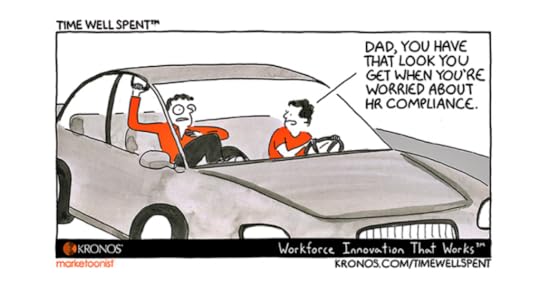
Compliance is a necessary part of business.
Accounting departments have to be compliant. Manufacturing processes have
regulations they need to follow. Organizations have rules they need to adhere
to. And of course, human resource departments have compliance matters they must
also follow.
The point is, compliance is a part of the work
we do. Today’s Time
Well Spent from our
friends at Kronos illustrates how we should spend our
time finding ways to make compliance easier instead of getting angry,
frustrated, or worried about it.
Technology can help us monitor compliance.
One of the best things about today’s technology solutions is that compliance is
being built in. As a user, we don’t have to remember all of the compliance
related matters because they’re accounted for in the programming. For example, good
technology engages an algorithm when it comes to calculating hours for benefits
eligibility or overtime.
Employees need the right outlook about
compliance. IMHO, there’s no reason to make compliance a
villain. Yes, there will be laws we don’t like, but there will also be some
that we’re very happy to have. Employees should not be placed in a position
where being compliant is drudgery or something that only the “uncool” kids do.
No employee should be asked to bend or break the rules for the company.
Organizations should regularly monitor the
compliance landscape. Compliance is usually legal, or
government related (i.e. laws and legislation). If organizations think that
there are laws which negatively impact their business, they should speak to
their legislators about it. Educate
lawmakers on how proposed (or existing) legislation impacts the business and
employees. Don’t ignore the law, get it changed.
Compliance is always going to be a part of our
jobs. Organizations have the ability to make compliance-related matters less
scary and worrisome by purchasing
technology solutions with compliance built in and letting
employees know that being compliant is important and expected. Also, getting
involved and educating lawmakers can allow us to make a difference in what
types of compliance are created and enforced.
The post Compliance Does Not Have To Be Frightening appeared first on hr bartender.






Sharlyn J. Lauby's Blog
- Sharlyn J. Lauby's profile
- 10 followers



